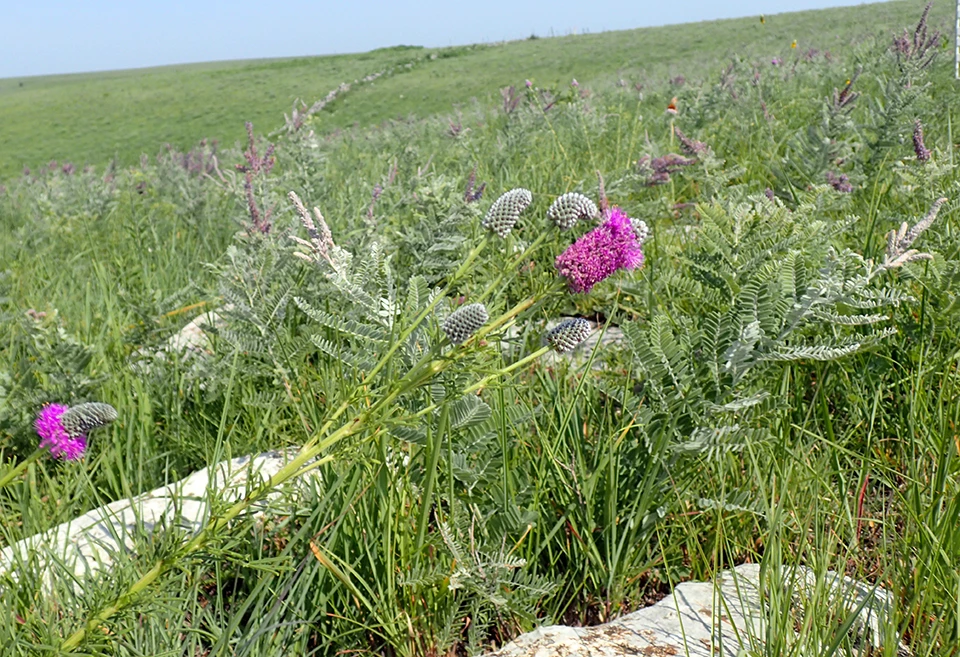Last updated: April 21, 2025
Article
Prairie Plant Community Monitoring at Tallgrass Prairie National Preserve: 2002–2023

NPS
Park Prairies
Tallgrass Prairie National Preserve is in the heart of the Flint Hills in Kansas and protects nearly 10,000 acres (4,047 hectares) of mostly remnant tallgrass prairie. Tallgrass prairies have important ecosystem functions: they support a large diversity of plants and animals, stabilize soil, filter water, prevent run-off during flooding, and store carbon. Less than 4% of the tallgrass prairie that once covered 170 million acres of North America remains today. These prairies are threatened by continued development, nonnative species, woody encroachment, and a changing climate.
Preserving tallgrass prairie is a main goal of park. Park managers use fire and grazing treatments to maintain a wide variety of conditions, vegetation structures, and microhabitats to maximize biodiversity and promote healthy tallgrass prairies. The Heartland Inventory and Monitoring Network monitors the park prairies to help managers protect these vanishing ecosystems.
What Do We Monitor?
We have monitored sites in the western portion of the park since 1997, but our methods were not finalized until 2002. Sites are located mostly in tallgrass prairie with a few sites in rocky mixed prairie. We collect information on climate, fire history, stocking rates of grazing animals, the amount of plant and other materials covering the ground, the number and cover of prairie plant species, and the number of tree seedling and saplings. These measurements allow us to assess the current condition of the park's tallgrass prairie and track the plant community over time. Monitoring data are also used to evaluate the effectiveness of fire and grazing treatments and understand how well the prairie community is meeting the habitat needs of park animals, including the iconic greater prairie-chicken.

NPS
Plant Communities 2002–2023
The park is successfully supporting characteristic tallgrass prairie plant species. There has been a small shift in the composition of native species. These types of shifts may be related to a reduction in disturbance intensity and a changing climate. Disturbance from grazing and fire has decreased since 2006 when the park began focusing on creating more varied habitats. These conditions help support a greater diversity of plants and animals, including the greater prairie chicken, a species with a wide range of habitat requirements. The park manages the prairies to maintain certain amounts of bare ground and litter and a low abundance of nonnative and woody plants.
We found that the amount of bare ground met the needs of the greater prairie-chicken across the preserve, but the amount of grass litter was high. There have been few nonnative plants since we began monitoring but they expanded from about half the sites in 2018 to about two-thirds of the sites in 2023. The most common nonnative species are bromes and Kentucky bluegrass. Native, woody plants are below the desired 5% threshold but continue to increase, especially in two of the pastures. In 2010 and 2014, we found a single elm seedling in one site, but in 2023 there were a small number of elm and hackberry seedlings. Increasing disturbance from grazing and fire or changing the timing of these disturbances may be needed to avoid woody plant expansion into the tallgrass prairie and to maintain the diversity of native prairie plants.
Climate data show a trend towards increasing moisture and days with heavy precipitation, which can cause the water to runoff rather than sink into the soil. Future climate models show two possibilities: a warm-wet future or a hot-dry future. Taking climate into consideration will be important for future management actions. Fires may need to be planned around changes in the timing of plant growth and flowering, and grazing plans may need to consider reducing animal stress and providing adequate water during times of drought.

NPS/Rob Bennetts
Species Highlight: Greater Prairie-Chicken
The greater prairie-chicken, an iconic tallgrass prairie species, is a large bird in the grouse family that resembles domesticated chickens in size and shape. They are sometimes called boomers because the male inflates his bright orange throat sac to make loud booming sounds that can be heard over a mile away. The greater prairie chicken relies on tallgrass prairie to survive and requires different prairie habitats at different points in its life cycle. Bare areas are important for lekking (communal breeding displays), warming, and finding insects to eat. More densely vegetated areas provide nesting spots and places to escape from predators. The chicks favor areas with a grass canopy for safety while eating.
Tallgrass Prairie National Preserve manages the park to maintain the variety of habitats required for greater prairie-chicken survival because it is an umbrella species. This means that protecting greater prairie-chickens helps protect most other species in the tallgrass prairie. We monitor park prairies to make sure the park is meeting its goals.
For More Information
View the Full Report.Visit the Heartland Inventory & Monitoring Network website.
Article created by the Heartland Inventory and Monitoring Network, 2025
